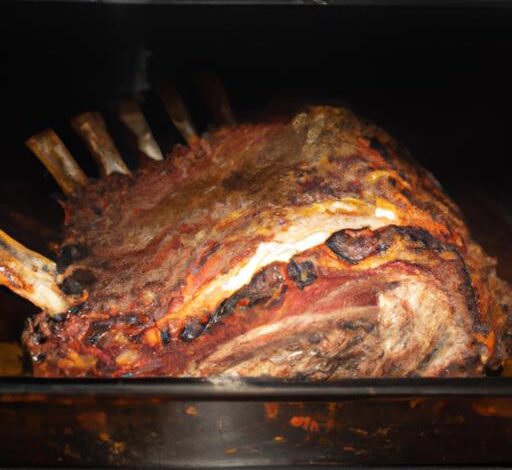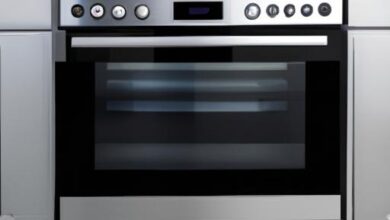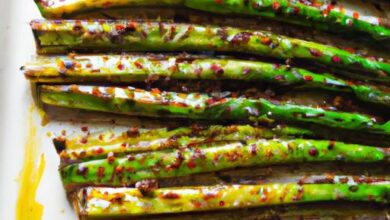Slow Cooking a Prime Rib in the Oven: Unleash the Art of Tender Perfection

Introduction
Imagine the tantalizing aroma of a perfectly cooked prime rib filling your kitchen, the anticipation of sinking your teeth into tender, juicy slices that melt in your mouth. slow cooking a prime rib in the oven is an art that elevates this exquisite cut of meat to new heights of flavor and tenderness. In this article, we will delve into the secrets of slow cooking a prime rib, uncovering why this method is ideal and the remarkable benefits it brings to your culinary experience.
The Art of Slow Cooking a Prime Rib in the Oven
Slow cooking is a method that allows the prime rib to gently cook at a low temperature over an extended period, resulting in succulent, evenly cooked meat. It’s a culinary masterpiece that requires patience and precision, transforming an already exceptional cut into a symphony of flavors.
Why Slow Cooking is the Perfect Method for Prime Rib
Prime rib, with its rich marbling and exceptional tenderness, is a cut of meat that deserves a method worthy of its quality. Slow cooking allows the meat to gently break down, rendering the fat and connective tissues to melt away, resulting in unparalleled juiciness and tenderness. This method ensures that every bite of prime rib is a divine experience, leaving you craving for more.
Benefits of Slow Cooking Prime Rib
Slow cooking prime rib not only creates a mouthwatering taste sensation but also offers a multitude of benefits. Firstly, the low and slow cooking process ensures a consistent level of doneness, eliminating any risk of overcooking or drying out the meat. Secondly, the extended cooking time allows the flavors to develop and intensify, creating a depth that will leave your taste buds in awe. Lastly, slow cooking allows for easy preparation and hands-off cooking, making it an ideal choice for stress-free entertaining.
Now that we understand the artistry behind slow cooking a prime rib in the oven, let’s explore the next step in this culinary adventure: selecting the perfect prime rib.
Selecting the Perfect Prime Rib
When it comes to slow cooking a prime rib in the oven, selecting the right cut of meat is crucial. Let’s explore the key factors to consider in order to ensure a truly exceptional dining experience.
Choosing a High-Quality Prime Rib Cut
To begin, prioritize finding a high-quality prime rib cut. Look for meat that is well-marbled, with streaks of fat running throughout. This marbling is what gives the prime rib its unparalleled tenderness and flavor. Seek out cuts from reputable butchers or trusted sources to ensure you’re starting with the best possible foundation for your slow-cooked masterpiece.
Factors to Consider When Selecting the Size of the Prime Rib
Determining the size of your prime rib is another vital consideration. Consider the number of guests you’ll be serving and the desired portion sizes. As a general rule of thumb, calculate approximately one pound per person, accounting for the bone weight. However, if you desire generous servings or leftovers, it’s wise to err on the side of caution and opt for a larger cut.
Importance of Marbling and Fat Content
Marbling and fat content play a pivotal role in slow cooking prime rib. The marbling within the meat not only enhances flavor but also contributes to the tender texture and juiciness. The fat slowly renders during the cooking process, basting the meat from within and infusing it with rich, succulent flavors. Remember, don’t be afraid of the fat – it’s the secret to achieving unparalleled mouthwatering results.
By carefully selecting a high-quality prime rib cut, considering the appropriate size, and embracing the marbling and fat content, you’re well on your way to creating a slow-cooked prime rib masterpiece. Now, let’s move on to the next step: preparing the prime rib for its journey to perfection.
Preparing the Prime Rib for Slow Cooking
There are a few crucial steps to ensure your prime rib is prepared to perfection before it undergoes the slow cooking process. Let’s dive into the essential aspects of preparing your prime rib for an unforgettable culinary experience.
Properly Thawing the Prime Rib
Before beginning the preparation, it’s vital to thaw the prime rib properly. Thawing in the refrigerator is the recommended method as it allows for a slow and even thawing process. Place the prime rib in a tray or dish to catch any potential drips, and ensure it is well-covered to prevent contamination. Remember, patience is key here, as thawing too quickly can affect the texture and flavor of the meat.
Seasoning Options for Flavor Enhancement
To elevate the taste of your prime rib, seasoning is the key. You have a world of options to choose from, each adding its unique touch to the final dish. A classic and simple seasoning consists of kosher salt and freshly ground black pepper, allowing the natural flavors of the prime rib to shine. For those seeking a bolder flavor profile, consider experimenting with garlic, herbs like rosemary or thyme, or even a dry rub of your favorite spices. Whatever your preference, ensure to evenly coat the prime rib for a balanced and flavorful outcome.
How to Properly Trim the Prime Rib
Trimming the prime rib is an essential step to ensure even cooking and an appealing presentation. Start by removing any excess fat or silver skin from the surface, being careful not to remove too much as the fat contributes to the overall flavor and tenderness. Additionally, you may want to consider tying the prime rib with kitchen twine to maintain its shape during the cooking process. This technique promotes even cooking and ensures a visually appealing final result.
With the prime rib properly thawed, seasoned to perfection, and expertly trimmed, we are now ready to move on to the next section: preheating and setting up the oven.
Preheating and Setting Up the Oven
Preheating the Oven for Slow Cooking Prime Rib
Before embarking on the journey of slow cooking your prime rib, it is crucial to preheat your oven properly. Preheating ensures that the oven reaches the desired temperature, allowing for even cooking and optimal results. Set your oven to the recommended temperature (typically around 250°F to 300°F) and allow it to preheat for at least 20-30 minutes.
Choosing the Right Temperature and Oven Setting
Selecting the right temperature for slow cooking your prime rib is essential to achieve the perfect balance between tenderness and doneness. Low and slow is the key here. Aim for a temperature between 250°F to 300°F, as this range ensures a gentle cooking process that yields perfectly juicy and tender meat. The lower end of the range will result in a more rare or medium-rare doneness, while the higher end will lean towards medium or medium-well.
Furthermore, it is crucial to select the appropriate oven setting for slow cooking. Opt for the “convection” setting if your oven has one, as it helps to circulate the heat evenly, ensuring consistent cooking throughout the prime rib. If your oven does not have a convection setting, the regular baking setting will also work well. Just be sure to position the prime rib in the center of the oven for balanced heat distribution.
Importance of Using a Meat Thermometer
To achieve the perfect level of doneness and ensure food safety, using a meat thermometer is paramount. Insert the thermometer into the thickest part of the prime rib, avoiding contact with any bones or fat. For medium-rare, aim for an internal temperature of around 135°F to 140°F, while medium should be around 145°F to 150°F. Remember, the meat will continue to cook slightly as it rests, so it’s best to remove it from the oven a few degrees below your desired final temperature.
By preheating the oven correctly, choosing the appropriate temperature and oven setting, and utilizing a meat thermometer, you’re setting yourself up for prime rib perfection. Now that we have the technical aspects covered, let’s move on to the exciting part – the slow cooking techniques that bring out the best in your prime rib.
Slow Cooking Techniques for Prime Rib
When it comes to slow cooking a prime rib in the oven, there are several techniques that guarantee exceptional results. Let’s explore these methods that will elevate your prime rib to a whole new level of perfection.
Slow-Roasting Method for Tender and Juicy Prime Rib
The slow-roasting method is a classic approach that ensures your prime rib is cooked to tender, juicy perfection. Start by preheating your oven to a low temperature, around 250°F (120°C). Place the seasoned prime rib on a rack in a roasting pan, allowing the heat to circulate evenly. Slowly roast the prime rib for several hours, depending on the size and desired level of doneness. This gentle cooking process allows the meat to retain its natural juices, resulting in a succulent and flavorful prime rib that will impress your guests.
Indirect Heat Method for Even Cooking
Another effective technique for slow cooking a prime rib is the indirect heat method. This method involves setting up your oven for indirect cooking, where the heat source is placed away from the prime rib. By creating a barrier between the prime rib and the direct heat, it ensures even cooking throughout. This can be achieved by placing a drip pan beneath the prime rib to catch any drippings and prevent flare-ups. The indirect heat method guarantees a consistent cook and minimizes the risk of any unevenly cooked areas, providing a prime rib that is uniformly tender and juicy.
Basting and Resting Techniques for Maximum Flavor
To further enhance the flavor and succulence of your slow-cooked prime rib, consider incorporating basting and resting techniques. Basting involves periodically brushing the prime rib with its own juices or a flavorful marinade during the cooking process. This adds layers of flavor and helps to keep the meat moist. Additionally, once the prime rib is cooked to perfection, it is crucial to allow it to rest for a period before carving. This resting period allows the juices to redistribute throughout the meat, resulting in a moist and tender prime rib that is bursting with flavor.
By utilizing these slow cooking techniques – the slow-roasting method, indirect heat method, and incorporating basting and resting techniques – you can achieve a prime rib that will leave your guests in awe of your culinary prowess. The next section will explore the final step in this delectable journey: serving and savoring your slow-cooked prime rib.
Serving and Enjoying Slow Cooked Prime Rib
Once you have mastered the art of slow cooking a prime rib in the oven, it’s time to indulge in the delectable results. Here are some tips for serving and savoring your slow-cooked masterpiece.
Properly Carving and Serving the Prime Rib
When it comes to carving the prime rib, it’s essential to use a sharp knife and a steady hand. Begin by allowing the meat to rest for about 15 minutes after removing it from the oven. This resting period allows the juices to redistribute, ensuring moist and succulent slices. To achieve picture-perfect slices, carve against the grain, creating thin slices that showcase the tender texture of the prime rib.
When serving, present the prime rib on a platter, garnished with fresh herbs for an elegant touch. The beauty of slow-cooked prime rib lies in its simplicity, allowing the natural flavors to shine.
Pairing Suggestions for Side Dishes and Sauces
To complement the rich and savory flavors of slow-cooked prime rib, consider pairing it with classic side dishes and sauces. Creamy mashed potatoes, roasted vegetables, and fluffy Yorkshire puddings are popular choices that provide balance and texture to the meal. For a burst of freshness, a crisp green salad or a tangy horseradish cream sauce can add a delightful contrast to the richness of the prime rib.
Tips for Storing and Reheating Leftovers
If you find yourself with leftovers (a rare occurrence with such a delectable dish!), proper storage and reheating are key to maintaining the prime rib’s quality. Allow the meat to cool before refrigerating it in an airtight container. To retain its juiciness upon reheating, place the slices in an oven-safe dish, cover with foil, and warm them in a low-temperature oven. This gentle reheating method will ensure that the prime rib remains moist and tender, just as delicious as the first time.
In conclusion, slow cooking a prime rib in the oven is an art that rewards your patience with unparalleled flavor and tenderness. From selecting the perfect prime rib to carving and serving it with finesse, each step contributes to a culinary experience that is truly extraordinary. So, gather your loved ones, ignite your oven, and embark on a journey of slow-cooked perfection that will leave everyone craving for more.
Conclusion: So above is the Slow Cooking a Prime Rib in the Oven: Unleash the Art of Tender Perfection article. Hopefully with this article you can help you in life, always follow and read our good articles on the website: pet.top5dalat.com





